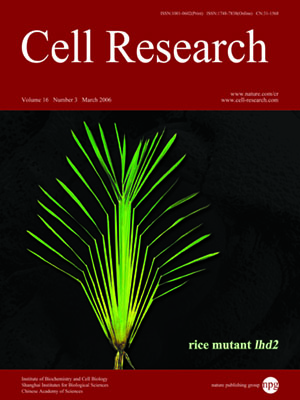
Volume 16, No 3, Mar 2006
ISSN: 1001-0602
EISSN: 1748-7838 2018
impact factor 17.848*
(Clarivate Analytics, 2019)
Volume 16 Issue 3, March 2006: 297-305
ORIGINAL ARTICLES
Reduced cardiac output is associated with decreased mitochondrial efficiency in the non-ischemic ventricular wall of the acute myocardial-infarcted dog
Zakaria A Almsherqi1, Craig S McLachlan2, Malgorzata B Slocinska1, Francis E Sluse3, Rachel Navet3,
1Department of Physiology, National University of Singapore, Block MD9, 2 Medical Drive, Singapore 117597, Singapore; 2Department of Medical Imaging, St Vincents Hospital, Melbourne, Fitzroy VIC 3065, Australia; 3Laboratory of Bioenergetics, Institute
of Chemistry B6, University of Li間e, Start Tilman, B-4000 Li間e, Belgium; 4Biophysics Laboratory, Division of Bioengineering,
National University of Singapore, Singapore 117576, Singapore; 5Department of Biochemistry, Shanghai Medical College of Fudan
University, Free Radical Regulation Research Center of Fudan University, Shanghai 200032, China
Correspondence: Yuru Deng(phsdy@nus.edu.sg )
Cardiogenic shock is the leading cause of death among patients hospitalized with acute myocardial infarction (MI). Understanding the mechanisms for acute pump failure is therefore important. The aim of this study is to examine in an acute MI dog model whether mitochondrial bio-energetic function within non-ischemic wall regions are associated with pump failure. Anterior MI was produced in dogs via ligation of left anterior descending (LAD) coronary artery, that resulted in an infract size of about 30% of the left ventricular wall. Measurements of hemodynamic status, mitochondrial function, free radical production and mitochondrial uncoupling protein 3 (UCP3) expression were determined over 24 h period. Hemodynamic measurements revealed a > 50% reduction in cardiac output at 24 h post infarction when compared to baseline. Biopsy samples were obtained from the posterior non-ischemic wall during acute infarction. ADP/O ratios for isolated mitochondria from non-ischemic myocardium at 6 h and 24 h were decreased when compared to the ADP/O ratios within the same samples with and without palmitic acid (PA). GTP inhibition of (PA)-stimulated state 4 respiration in isolated mitochondria from the non-ischemic wall increased by 7% and 33% at 6 h and 24 h post-infarction respectively when compared to sham and pre-infarction samples. This would suggest that the mitochondria are uncoupled and this is supported by an associated increase in UCP3 expression observed on western blots from these same biopsy samples. Blood samples from the coronary sinus measured by electron paramagnetic resonance (EPR) methods showed an increase in reactive oxygen species (ROS) over baseline at 6 h and 24 h post-infarction. In conclusion, mitochondrial bio-energetic ADP/O ratios as a result of acute infarction are abnormal within the non-ischemic wall. Mitochondria appear to be energetically uncoupled and this is associated with declining pump function. Free radical production may be associated with the induction of uncoupling proteins in the mitochondria.
Cell Research (2006) 16:297-305. doi:10.1038/sj.cr.7310037; published online 16 March 2006
FULL TEXT | PDF
Browse 1898


